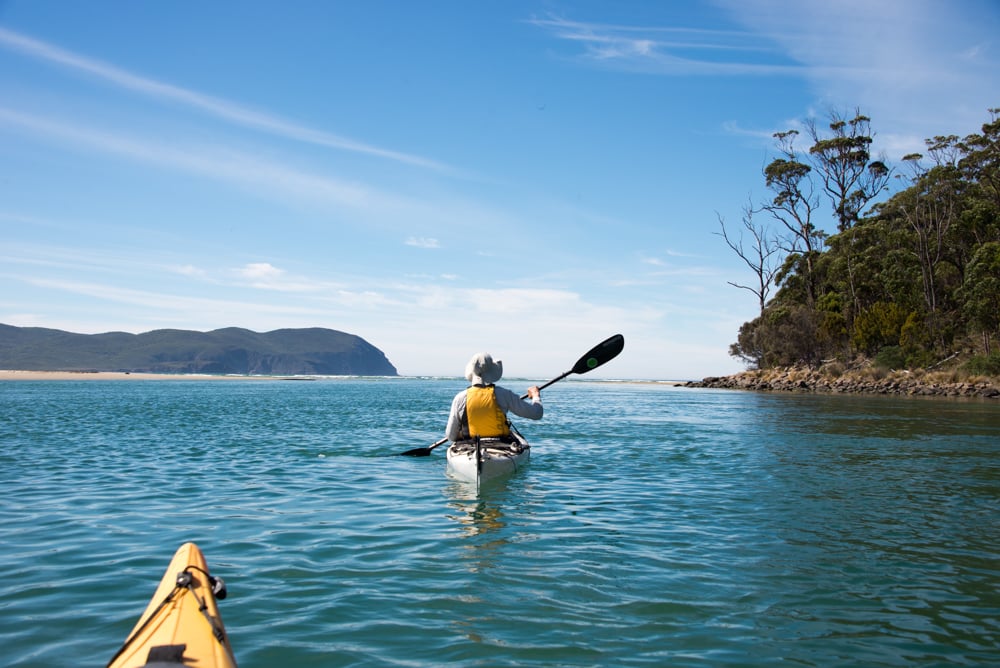If Tasmania is on your travel radar, you need to know there’s more to the Apple Isle than its most hyped destinations. We’ve selected the top 10 places to see in Tasmania along the East and West coasts. Our choices will reveal some surprises, including some of the state’s most spectacular island groups (ones you probably never even knew existed)! Read on to discover the top Tasmania sights, wildlife, and activities.
The beauty of Tasmania’s coastline is often overlooked for some of Australia’s most well-known attractions. It only takes one trip to Tasmania, however, to realise the Apple Isle is worthy of more than just a city stay to see its countless scenic wonders and attractions. Discover the highlights beyond the basics on our Coastal Tasmania: Untouched Wilderness expedition!
With a perfectly crafted itinerary, we’ll show you the best places to see in Tasmania. All in the comfort of our brand-new Douglas Mawson expedition ship. See coastal gems and the state’s far-flung islands where abundant wildlife wanders, pristine, untouched scenery, and historical and cultural treasures await. With over 33 years of experience planning enthralling expeditions around the world, see the best Tasmania sights with the experts.
The itinerary, activities and excursion schedule are a guide only and subject to change due to permitting and regulatory approvals; and weather, sea state and other conditions beyond our control.

Exploring the East Coast of Tasmania
1. Freycinet National Park & Wineglass Bay
Perhaps one of Tasmania’s most breathtaking regions, the Freycinet Peninsula, including the UNESCO World Heritage-listed Freycinet National Park and Wineglass Bay, is a destination where the colours are so vibrant and complementary paint companies probably travel here to create their new season colour wheel.
Witness pristine white sand beaches, water the colour of Bradley Cooper’s eyes, salmon-pink granite peaks (known as the Hazards), and lime-green grass trees that fan so broadly, you can’t help but run your fingers through them.
Amid nature’s bounty, there are wildlife friends to encounter, too. Like bottlenose dolphins, shy wallabies, and on nearby Schouten Island, gangs of fur seals basking in the sun.
At Wineglass Bay, one of Australia’s best beaches, walk 20 minutes at the southern end to the lookout to marvel at the spectacular vistas – some of the best views in Tasmania, including the three jagged peaks of the Hazards.
2. Maria Island & Painted Cliffs
With a nickname of being Australia’s Noah’s Ark, Maria Island is an idyllic place to meet a plethora of native wildlife, including the Tasmanian devil, Bennetts wallabies, dainty pademelons, and stocky wombats. Your chances of seeing almost all Tasmania’s endemic bird species are also high here.
While Maria Island is only a short distance from the mainland, its separation from it – and its car-free status – have contributed to the survival of many species. Maria Island is considered one of the best places in Tasmania, accessible from Hobart.
A top Maria Island attraction is the Painted Cliffs, popular for the remarkable iron swirls and whorls in the sandstone, evidence of art in nature. Walk the 4.5-kilometre Painted Cliffs Track at low tide.
The traditional custodians of the island are traced as far back as 40,000 years. The Puthikwilayti people of the Oyster Bay tribe lived a simple life in harmony with and in protection of Maria island’s land and water until Europeans came ashore in 1789. In 1825, 50 convicts were brought to the island for hard labour. The intact Darlington Probation Station is now a UNESCO-protected site.
3. Port Arthur
European settlers chose Port Arthur as a convict settlement, now Tasmania’s most notorious. Now Port Arthur Historic Site, this former prison stands in stark contrast to the region’s beauty. The well-preserved buildings and interactive exhibits of this open-air museum – one of the best tourist destinations in Tasmania – afford insights into the sombre history of its 12,500 imprisoned convicts.

4. Bruny Island & Recherche Bay
Another of Tasmania’s spectacular wonders, Bruny Island offers more than just its stunning natural beauty and fabulous wildlife… it’s famous as a foodie destination, too!
At the southern tip, South Bruny National Park awaits. It’s a destination perfect for picturesque coastal walks, active headland hikes, and leisurely rests on the island’s soft sand beaches. The south is also where you’ll meet the lumbering fur seals and adorable fairy penguins. Bruny Island’s other top native residents include wallabies, echidnas, and brushtail possums.
For gourmands, you’ll love the local’s focus on artisanal produce. Whether it’s sampling handmade chocolate, creamy cheese treats, succulent seafood nibbles, or discovering flavour combinations you would never have considered, Bruny Island is a sensory destination for your palate.
On our Coastal Tasmania sailing, we’ll show you Recherche Bay to learn of the exploits of French explorer Bruni D’Enrecasteaux and the history of the Indigenous Lylequonny people.
5. Bay of Fires
The Bay of Fires (Larapuna) is undeniably a top highlight on Tasmania’s northeast coast. For over 50 kilometres, the unspoiled natural beauty impresses visitors, from the pristine beaches to the azure waters to the orange-lichen-covered boulders that pepper the beaches.
An outdoor lovers’ paradise, the Bay of Fire offers ample activities to soak up its serenity. Whether it’s swimming or snorkelling at Binalong Bay, wildlife spotting for dolphins and migrating whales (in winter) or hiking the popular Larapuna Trail in the Bay of Fires Conservation Area, a great time is guaranteed.
Exploring the West & North Coast of Tasmania
6. Maatsaykya Island
You may not have heard of Maatsuykya Island, but that’s part of the appeal. Located off the southern coast, this remote and rugged gem is part of Southwest National Park, a UNESCO World Heritage Site.
Perched high on a cliff, the 19th-century Maatsuykya Island Lighthouse is a striking landmark against the uninhabited island. In fact, only two volunteers reside here temporarily to protect the lighthouse heritage and undertake caretaking duties.
While the lighthouse makes for a great photo, the wildlife is the real drawcard to Maatsyukya Island. It’s a haven for seabirds, including albatross, shearwaters, and little penguins. Australian fur seals use Maatsyukya to rest, New Zealand fur seals to breed, and southern elephant seals are spotted occassionally, too.
As the island is protected and visitation limited, we’ll cruise around Maatsuykya on our Coastal Tasmania journey.

7. Port Davey
Also in Southwest National Park, Port Davey is an untouched wilderness ripe for adventure. Surrounding this secluded harbour, visitors love the craggy mountains, lush forests, and Port Davey’s raw beauty.
Hiking is the top activity at this oceanic inlet, offering trails that provide stunning views of the towering Davey Range peaks and serene waters below. Kayaking Bathurst Harbour gets you up close to dolphins and seals, with sea eagles swooping overhead.
8. Hunter Islands
Located in the Bass Strait, off the northwest coast, the remote Hunter Islands are a rarely visited archipelago, including Hunter Island, Three Hummock Island, and Albatross Island, a wildlife sanctuary with over 50,000 pairs of shy albatross. While the stark geological beauty is worthy of praise, it is their ecological significance that wows.
On our Coastal Tasmania sailing, watching the skies, we hope to spot the distinct fauna that calls these islands home, including several threatened species, like the Tasmanian wedge-tailed eagle, fairy prion, swift and orange-bellied parrots, and white-bellied sea eagles.
Although named after the Governor of the Colony of New South Wales in 1798, there’s evidence of over 23,000 years of continuous occupation by the traditional Aboriginal custodians on the Hunter Islands.
9. Kent Islands
The fact the Kent Islands are often missed on conventional maps and definitely missed off Tasmania itineraries does not correlate with how much these remote islands offer.
Thanks to a convergence of three major ocean currents, Tasmania’s northernmost national park is rich in natural wonders, with wildlife highlights including Australia’s largest fur seal colony, soaring petrels, short-tailed shearwaters, and sooty oystercatchers.
Australia’s oldest lightkeepers cottage is here, run by the island’s two only residents. Now a museum, the exhibits reveal tales of shipwrecks, sailors, and sealers.

10. Flinders Island
Once called the Great Island, Flinders Island is Tasmania’s largest island and home to Strzelecki National Park. Located off the state’s northeast tip, granite headlands rise from the Bass Strait, looming over untouched white-sand beaches, aquamarine waters, and the verdant casuarina woodlands.
Activity-wise, Flinders Island holds appeal great for hikers who rate the Strzelecki Peak trail for its challenging yet rewarding terrain and spectacular views. Kayaking is a great way to intimately explore the beautiful coastlines here.
Southern Lights Viewing Locations
Tasmania offers Australians a prime viewing location to witness the ethereal lights of aurora australis, the Southern Lights. While year-round solar activity can create the Southern Lights, during the Australian winter, when the nights are longest and darkest, your chances increase. Seeing the shimmering waves of green, pink and yellow lights dancing and crackling across the night sky is the stuff of legends and bucket lists.
As experts in showcasing the aurora borealis to our Arctic guests, we also understand the best locations to witness the Southern Lights in Tasmania. Although our December voyage might not align with the prime viewing season for the Aurora Australis, Tasmania offers numerous remote spots ideal for this phenomenon.
Light pollution can hinder visibility, so while many prime viewing locations are inland and challenging to access, our Coastal Tasmania tour visits some of the state’s renowned dark sky areas. These include the expansive skies of Bruny and Maria Islands, Cockle Creek in Southwest National Park, and the picturesque Coles Bay in Freycinet National Park.
Exploring Tasmania with Aurora Expeditions
Under the guidance of our passionate and experienced Expedition Leaders, your journey with us includes daily off-ship adventures and explorations that show you the best sights in Tasmania. This includes the option to hike some of the state’s best (and least-known) walks, kayaking serene island bays, and watching wildlife from our Zodiac cruise boats.
When exploring Tasmania by ship, you see so much more of its beauty and natural gems, including several pristine destinations that few travellers ever see. Tasmania’s rich geological, biological and long human history is woven into each day, further bringing to life the real Tasmania.
To discover the best of Tasmania with the experts, contact our friendly team or request an online quote.
Coastal Tasmania: Untamed Wilderness
Discovery Expedition
Revel in the opportunity to tread some of Tasmania’s greatest coastal tracks while you circumnavigate this island state by sea. Land on remote pristine beaches; trek through coastal heath, buttongrass...
11 Days
From USD $9,430.75/pp







